Introduction: Advanced Structural Design And Bridge Engineering
Structural design deals with a specific area in civil engineering. It is discussed by the set of the method, which determines the safe and economic condition of the structure. The bridge design and the material constituted the data and the phase which is involved with the bridge selected portion and the data. A different factor mentions the design process in selecting data and the materials that justify the methods. Structural design can be defined as a methodology that helps to investigate the strength, stability, and rigidity of any structure. The primary objective of structural analysis is to make a capable structure that is able to resist the applied loads without any failure. A well-designed structure analysis reduces the possibility of cost faired. The structural design may be divided into sub-parts which can help to understand the topic more clearly. The subparts can be defined as planning, designing, and constructing. This study has given a brief idea about structural design and helps to understand the benefits of structural design in bridge engineering.
Explore unparalleled assignment help UK with Native Assignment Help. Our commitment to quality and customer satisfaction sets us apart, making us the preferred choice for students seeking reliable assistance.
Objectives
- To determine the critical evaluation of the structural material which is a large member of structures.
- To discuss the structural theories and the methods for the analysis which is relevant to the structure.
- To evaluate the code of the practice.
- To determine the performance structure of the design and the steel.
- To select the composite of restressed concrete tensile cables and the deck elements.
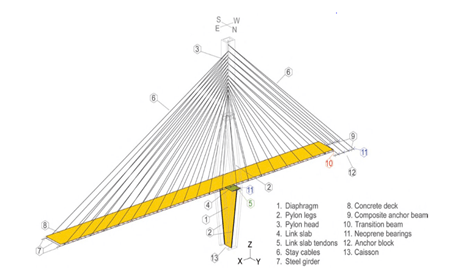
Figure 1: Chirajara bridge elevation
Discussion
Clear analysis of the bridge
The main component of the bridges is the different parts that deal with the foundation and the substructure and the superstructure of the core area which has different parts of the bridges. The pile and the pile caps are constructed for the foundation aspects of the bridges. The main part of the bridges is dealt with detailed information and data consideration that make the core areas of the bridges (Graybeal et al.2020). This core area deals with the three main components: the bridge's foundation, the bridge's substructures, and the bridge's superstructures. In the cable-stayed bridge, the bridge is designed with a concrete beam bridge that is based on the cantilever. The total length of the bridge was 460 meters. This bridge has a configuration of 192+114.6+114.6 meters. On this, there will be a height of 54 meters, and also the piers will be 54 meters. The design of the new beam will come after the cable-stayed shape is “V”. This configuration has been scrapped and also it was replaced with the original cable-stayed tower that collapsed. Also, the shape was a diamond. This bridge collapsed in 2018. With this situation, the record was tarnished and in the back 60 years, not a single cable-stretching bridge collapsed.
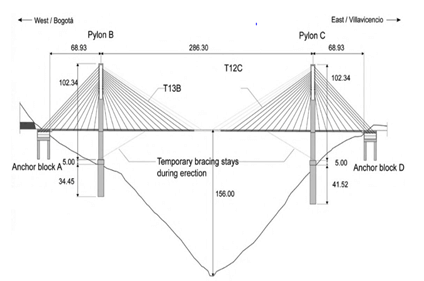
Figure 2: Bridge section
The first cable-stayed bridge that was modern was made in 1957. The year of 2018 and the date was 15th January the side was nearly finished and the connections of the bridge that worked with the construction. During the investigation, it was discovered that the connection was horizontal and the shape was like a diamond (Marín et al.2019). The design is insufficient and it has a minimal number of restressing cables and also an insufficient design. It had calculations that were incorrect. This was having a length that was insufficient. The diagram of the concrete was connected to the “V” shape that will be the lower and it also has the study that will be providing the shape of the bridge. The cross beams that are using concrete. The several rows of the cable that will be restressing and also the thickness will be 6 meters. For the chirajara cable-stayed bridge there will be the diaphragm that was found for loads of the design. The loads are calculated during the erection (Mascolo et al.2020). The lack of shared forces is resulting in the stages of the service. The connector of the share was missing and also it was having the instability that will be the formation of the concrete that provided the action that was composited.
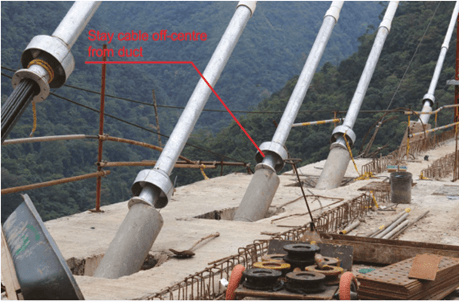
Figure 3: Bridge pylon
The connection was expected that withstand was having the share force that will be with the loads which will be part of the structure. This was having the direction which was respecting the forces that will be considering the forces that are shear force and these forces are expected that the loads that are the design loads which was the failure that is potential (Galvão et al.2021). In the anchor, the assembly will be accommodated as also the design of the loads that are in the stages of the service. In the reinforcement of the face that is top and it was provided that the action was composite, which is the lateral reinforcement of the shear force. The hives that are resting the instability and it included the hinges that are with local plastic.
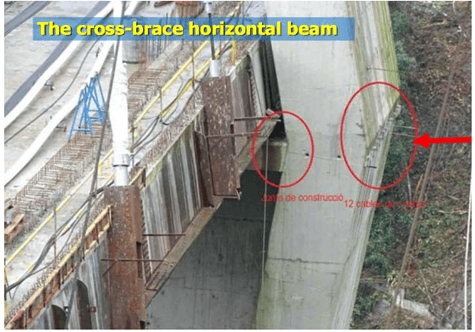
Figure 4: Bridge horizontal condition
It was provided that the connectors were ensuring the action that was provided. The bridge is integrated by the development of the properties of the bridge and the different elements of the bridge. The bridges are determined by the construction and the element of the bridges which is mentioned in the plan of the structures. The different elements of the building approaches determine the structural element and the properties.
Critical analysis of the appropriate particular design of the bridge
In the bridge, the height of the pier will be 34.45 meters. The height of the pile cap will be 5 meters. The height from the top level of the pile cap to the top of the bridge will be 1025.34 meters. The height of the bridge deck from the ground level will be 156 meters. The bridge length will be from one pylon to another Pylon which is 286.30 meters. The whole bridge length will be 424.16 meters. The elastic connection of the erected will be considered and it was unstable. This will be very prone to the vortex of the shedding of the excitation.
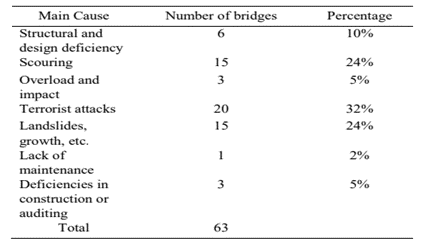
Figure 5: Cause of collapse of the bridge
In the alternative, there is a problem with the mitigation and it will also reduce the stability of the structure of the bridge. The instrumentation of the bridge, Control system, and monitoring, also it will consist of the system that is having the instrumentation. This data acquisition is allowed. This data is stored and also analyzed. It will alert the establishment and it is the behavior of the structure. It will avoid the collapse and also it will be associated with the technology and it will also be collected at the lecture (Daheshpour et al.2018). In the two possible cases, they are classified. It will be located under the road construction that is a part of it. The state of the authority will be performed and formulates the process of the section. The process of the section for the structure of the bridge is performed and formulated. The process of the selection will be designated by the contractor and it will be also relevant for the auditor. This execution is with the contract. After finishing the construction it will be delivered to the section of the work. This will depend upon the life cycle and also the bridges. In the construction, there will be the basic instrumentation that should be during the implementation of the construction of the bridge. This will be verifying the order of the c construction. It will currently be monitoring the bridges that are active and it will be inspected by the elements of the structure. It will be a sign that it has a grade that depends upon the qualitative and also quantitative section (Agwoko et al.2021). There are many factors that will then cause the failure of a bridge, Due to the design and structural deficiency of the bridge. The overloads are also responsible for the failure of the bridge. During the design, a maximum load-carrying capacity is considered and also considered the safe load so that in any situation if the load is exceeded the bridge won't crack and also it will not fail. In the clarification of the
The final structure of the bridge provides the advantage
The main benefit of the bridge's instrumentation or the monitoring process is the control system, which lies in having the data behave on the structure in real-time. They analyzed the process and stored it properly on the right range and the sight of the structure when it behaves in the way that is required. It describes the beginning process of the IMC from the process of the construction of the structure. It maintains the acquired data from the behaviors. The performance and the installation process are embedded in the equipment properties of the concrete. Even in the construction stages, it is possible to establish the range of the structure and its material behaviors. It determines the material possibility for the imminent structure that is collapsing (Mitoulis et al.2022). It is solving the problem and describes the part of the introduction fields. The data of the bridge element and the structure is also possibly the main factor and the analysis mentions the appropriate analysis and the state of the behaviors of the isolated properties of the elements. This is susceptible and maintains the reinforcement warning of the malfunction and the different types of additional expenses of the bridges which deal with the closed road and the corridor.
Implementation of the bridges
As per the design and the view of the structure the bridge is developed by the fireproofing system for the bridges. The seismic load and the design and the different types of retrofit are assembled in every step when the constitution works are running. The loathing condition of the bridges checks at every step. The composite material and the bridge deck are determined by the development and the analysis of the factor which is mentioned as per the proper requirement of the analysis code and the design aspects (Pizarro et al.2020). The aesthetic goal and the rail of the bridge is provided in every section of the bridge. Provide the new technology and the development which is inspecting the values and the submerged effects on the support and the structure. Information technology adds the building information system and the modeling which mention the proper environment and the sustainable development of the factor. Modern technology deals with modern material which has major changes in their properties and it reacts to the bridge design and the ratio. It connects every step and is efficient for the various concepts of the design structure which is mentioned. Innovate the new and modern type of technology that maintains the material of the bridges and the self-healing of the gradation of the concrete b. The life cycle process of the concrete is determined due to the various types of load which is occurring in the bridges and the prone connection of the bridge cracking. The concrete and the mixture include the different limestone and produce the bacterial deficit which is developing the crack and they form contribution steep breaks. Their ferret looks at natural type disasters such as earthquakes and tornadoes, which is an important fact that considers the design tool and the techniques of the bridges.
Fatal study
It is defined that the chirajara bridge includes the support pile which is collapsed because it influences and inaccurate the assumption and the regarding aspect which is capacity for withstand is based on the supporting condition and the aspects of the method of design. The rule and the techniques is deals with the disaster which is caused by different types of poor materials. This is suggested by the demolition process which is already complete in the second phase of the bridges and it supports the large structure of the design which is designed as per the element and the pile which is collapsed. As a result, nine workers fall into the earth while it it working on the above levels.
Conclusion
The best way to avoid the different types of failure is to set a plan for the entire process. There is only one way to protect the very injuries which are related to loss of life and properties which is to damage the different aspects and the destruction process. It is interested in the process which is learning about the way and the improvement of the bride design and the construction process and their quality in every step. The design porches and the error and the mistake which is related to the constitution process which deals with the hydraulic porches and the collision and the process of the overload condition at the first stages.
Reference list
Journals
Agwoko, M.P., Chen, Z., Liu, H. and Wang, X.D., 2021. A study of collapse susceptibility and resistance of loaded cable-supported pipe structure subject to a sudden break of cable member.Advanced Steel Construction,17(3), pp.283-293.
Daheshpour, K. and Herbert, S., 2018. Infrastructure project failures in Colombia.
Galvão, N., Matos, J. and Oliveira, D.V., 2021. Human Errors induced risk in reinforced concrete bridge engineering.J. Perform. Constr. Facil,35(4).
Galvão, N., Matos, J. and Oliveira, D.V., 2021. Human Errors induced risk in reinforced concrete bridge engineering.J. Perform. Constr. Facil,35(4).
Graybeal, B., Brühwiler, E., Kim, B.S., Toutlemonde, F., Voo, Y.L. and Zaghi, A., 2020. International perspective on UHPC in bridge engineering.Journal of Bridge Engineering,25(11), p.04020094.
Marín, C.J.B., Reinosa, J.S.L. and Muñoz, J.S.J., 2019. IMPACTO SOCIAL, ECONÓMICO Y AMBIENTAL DEL COLAPSO DEL PUENTE CHIRAJARA.Encuentro Internacional de Educación en Ingeniería.
Mascolo, I. and Modano, M., 2020. Optimisation of suspended-deck bridge design: a case study.Australian Journal of Structural Engineering,21(3), pp.244-253.
Mitoulis, S.A., Domaneschi, M., Cimellaro, G.P. and Casas, J.R., 2022, September. Bridge and transport network resilience–a perspective. InProceedings of the Institution of Civil Engineers-Bridge Engineering(Vol. 175, No. 3, pp. 138-149). Thomas Telford Ltd.
Pizarro, A., Manfreda, S. and Tubaldi, E., 2020. The science behind scour at bridge foundations: A review.Water,12(2), p.374.
Prendergast, L.J., Limongelli, M.P., Ademovic, N., Anžlin, A., Gavin, K. and Zanini, M., 2018. Structural health monitoring for performance assessment of bridges under flooding and seismic actions.Structural Engineering International,28(3), pp.296-307.
Xia, L., Xia, Q., Huang, X. and Xie, Y.M., 2018. Bi-directional evolutionary structural optimization on advanced structures and materials: a comprehensive review.Archives of Computational Methods in Engineering,25(2), pp.437-478.
Zhou, M., Lu, W., Song, J. and Lee, G.C., 2018. Application of ultra-high performance concrete in bridge engineering.Construction and Building Materials,186, pp.1256-1267.


